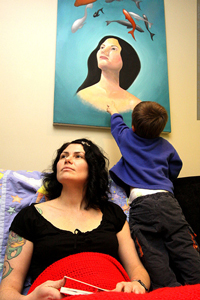
Source: Seeing double, Handolio, Flickr
Is it easier to see one car or two cars, one maple leaf or two maple leaves, one pigeon or two pigeons? What do you think?
You might ask what is meant by “see.” If “see” means finding something you're searching for, then it is easier to see two of anything than just one. Two are easier to spot than one.
If the objects are similar and you're looking for differences, it can be more interesting to stop and take notice. Looking at two identical postage stamps, for instance, probably won’t make you take notice. If there is something different about them, however—maybe one has a tiny rip, smudge, or crease—then you may take notice. This sounds like detective work, like looking for clues. In a sense, it is detective work to look for the differences between two similar things, but doing so helps you increase the sensitivity and accuracy of your observations.

Source: Sequoia noticing a similarity between his mom and the painting of the girl with fish on her head - _MG_6811.embed, sean dreilinger, Flickr
When you read a poem, story, or essay, you may think you have paid close attention and fully understood it, but if you read and compare two similar poems, you will see much more.
You might notice a difference in the way the poems begin. You might notice a similarity in the figures of speech. You might even notice a slightly different approach to the same theme.
We read in relation to our experience. When we connect our reading strongly with our experience, we read with more interest. When we read with interest, a conversation goes on between what we are reading and our experiences. By the same token, a conversation goes on between what we are reading now and what we have read at an earlier time. Reading one text and then another similar text will almost always increase our understanding and appreciation of both. How reading one text relates to reading another text is called intertextuality.
Although you read intertextually all the time (whether you choose to or not), the richness that such reading brings is greatly increased when you are aware of how your reading connects to other texts. Imagine the power you can add to your reading by looking at how texts are similar and how they are different. Doing this involves consciously allowing a conversation to occur between what you are reading now and what you have read before that connects to the present text.
In this lesson, you will read and annotate a pair of texts to make inferences, draw conclusions, and synthesize ideas and details using textual evidence. Prepare to see double. You are going to look at two texts together to better understand them.